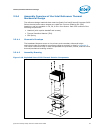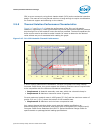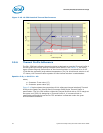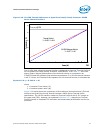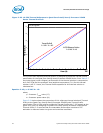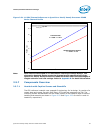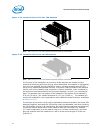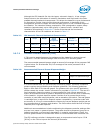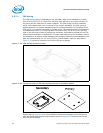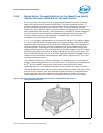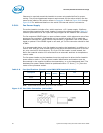
Quad-Core Intel® Xeon® Processor 5400 Series TMDG 47
Thermal/Mechanical Reference Design
Although the CEK heatsink fits into the legacy volumetric keep-in, it has a larger
footprint due to the elimination of retention mechanism and clips used in the older
enabled thermal/mechanical components. This allows the heatsink to grow its base and
fin dimensions, further improving the thermal performance. A drawback of this
enlarged size and use of copper for both the base and fins is the increased weight of
the heatsink. The retention scheme employed by CEK is designed to support heavy
heatsinks (approximately up to 1000 grams) in cases of shock, vibration and
installation as explained in Appendix E. Some of the thermal and mechanical
characteristics of the CEK heatsinks are shown in Ta ble 2 -7.
2.5.7.2 Thermal Interface Material (TIM)
A TIM must be applied between the package and the heatsink to ensure thermal
conduction. The CEK reference design uses Shin-Etsu G751 thermal grease.
The recommended grease dispense weight to ensure full coverage of the processor IHS
is given below. For an alternate TIM, full coverage of the entire processor IHS is
recommended.
It is recommended that you use thermally conductive grease. Thermally conductive
grease requires special handling and dispense guidelines. The following guidelines
apply to Shin-Etsu G751 thermal grease. For guidance with your specific application,
please contact the vendor. Vendor information is provided in Appendix F. The use of a
semi-automatic dispensing system is recommended for high volume assembly to
ensure an accurate amount of grease is dispensed on top of the IHS prior to assembly
of the heatsink. A typical dispense system consists of an air pressure and timing
controller, a hand held output dispenser, and an actuation foot switch. Thermal grease
in cartridge form is required for dispense system compatibility. A precision scale with
an accuracy of ±5 mg is recommended to measure the correct dispense weight and set
the corresponding air pressure and duration. The IHS surface should be free of foreign
materials prior to grease dispense.
Additional recommendations include recalibrating the dispense controller settings after
any two hour pause in grease dispense. The grease should be dispensed just prior to
heatsink assembly to prevent any degradation in material performance. Finally, the
thermal grease should be verified to be within its recommended shelf life before use.
The CEK reference solution is designed to apply a compressive load of up to 133 N
[30 lbf] on the TIM to improve the thermal performance.
Table 2-7. CEK Heatsink Thermal Mechanical Characteristics
Size
Height Weight
Target
Airflow
Through Fins
Mean Ψ
ca
Standard
Deviation Ψ
ca
Pressure Drop
(mm) [in.] (kg) [lbs]
(m
3
/hr)
[CFM]
(°C/W) (°C/W) (Pa) [in H
2
O]
2U+ 50.80 [2.00] 1.0 [2.2] 45.9 [27] 0.177 0.0033 45.3 [0.182]
1U 27.00 [1.06] 0.53 [1.2] 25.5 [15] 0.240 0.0023 82.4 [0.331]
Table 2-8. Recommended Thermal Grease Dispense Weight
Processor Minimum Maximum Units Notes
TIM Dispense weight 400 mg Shin-Etsu* G751. Dispense
weight is an approximate target.
TIM loading provided
by CEK
18
80
30
133
lbf
N
Generated by the CEK.



